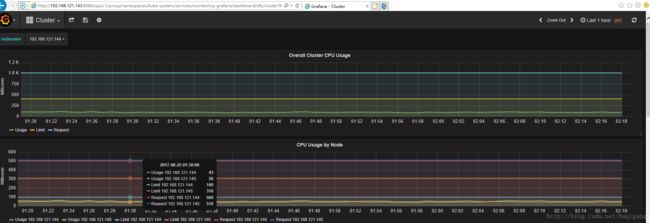kubernetes学习记录(10)——建立Heapster+Influxdb+Grafana集群性能监控平台
采用的是Heapster+Influxdb+Grafana建立集群性能监控平台。
据说Heapster需要与Kubernetes Master进行安全连接,所以需要对集群进行安全认证,我的集群环境已经进行了安全认证。
非安全认证的集群能否使用Heapster,我没有验证。
集群的安全认证可以参考我的博客kubernetes学习记录(9)——集群基于CA签名的安全设置(可能有坑,这块还没研究的特别明白,网上的各种认证方式都有,我是综合参考的,不一定完美)
参考博客Kubernetes heapster监控插件安装文档与在开启TLS的Kubernetes1.6集群上安装heapster进行整理。
从作者分享的地址下载所需的镜像文件,Push到自己的本地镜像仓库中。
index.tenxcloud.com/jimmy/heapster-amd64:v1.3.0-beta.1
index.tenxcloud.com/jimmy/heapster-influxdb-amd64:v1.1.1
index.tenxcloud.com/jimmy/heapster-grafana-amd64:v4.0.2yaml源码来源自kubernetes GitHub。
安装Heapster
heapster-deployment.yaml
修改- --source为自己的master apiserver访问地址
修改image地址
apiVersion: extensions/v1beta1
kind: Deployment
metadata:
name: heapster
namespace: kube-system
spec:
replicas: 1
template:
metadata:
labels:
task: monitoring
k8s-app: heapster
spec:
containers:
- name: heapster
image: 192.168.121.140:5000/heapster-amd64
imagePullPolicy: IfNotPresent
command:
- /heapster
- --source=kubernetes:http://192.168.121.143:8080
- --sink=influxdb:http://monitoring-influxdb:8086
- --metric_resolution=60sheapster-service.yaml
apiVersion: v1
kind: Service
metadata:
labels:
task: monitoring
# For use as a Cluster add-on (https://github.com/kubernetes/kubernetes/tree/master/cluster/addons)
# If you are NOT using this as an addon, you should comment out this line.
kubernetes.io/cluster-service: 'true'
kubernetes.io/name: Heapster
name: heapster
namespace: kube-system
spec:
ports:
- port: 80
targetPort: 8082
selector:
k8s-app: heapster创建deployment和service
#kubectl create -f heapster-deployment.yaml
#kubectl create -f heapster-service.yaml安装Influxdb
influxdb 官方建议使用命令行或 HTTP API 接口来查询数据库,从 v1.1.0 版本开始默认关闭 admin UI,将在后续版本中移除 admin UI 插件。
开启镜像中 admin UI的办法如下:先导出镜像中的 influxdb 配置文件,开启插件后,再将配置文件内容写入 ConfigMap,最后挂载到镜像中,达到覆盖原始配置的目的。
$ #在镜像所在的宿主机上,导出镜像中的influxdb配置文件
$ docker run --rm --entrypoint 'cat' -ti heapster-influxdb-amd64:v1.1.1 /etc/config.toml >config.toml.orig
$ cp config.toml.orig config.toml
$ # 修改:启用 admin 接口
$ vim config.toml
修改第35行
< enabled = false
---
> enabled = true
$ #将修改后的config.toml拷贝到Master上,再将修改后的配置写入到ConfigMap对象中
$ kubectl create configmap influxdb-config --from-file=config.toml -n kube-system
$ # 将ConfigMap中的配置文件挂载到Pod中,达到覆盖原始配置的目的最终的influxdb-deployment.yaml文件如下:
apiVersion: extensions/v1beta1
kind: Deployment
metadata:
name: monitoring-influxdb
namespace: kube-system
spec:
replicas: 1
template:
metadata:
labels:
task: monitoring
k8s-app: influxdb
spec:
containers:
- name: influxdb
image: 192.168.121.140:5000/heapster-influxdb-amd64
volumeMounts:
- mountPath: /data
name: influxdb-storage
- mountPath: /etc/
name: influxdb-config
volumes:
- name: influxdb-config
configMap:
name: influxdb-config
- name: influxdb-storage
emptyDir: {}influxdb-service.yaml
apiVersion: v1
kind: Service
metadata:
labels:
task: monitoring
# For use as a Cluster add-on (https://github.com/kubernetes/kubernetes/tree/master/cluster/addons)
# If you are NOT using this as an addon, you should comment out this line.
kubernetes.io/cluster-service: 'true'
kubernetes.io/name: monitoring-influxdb
name: monitoring-influxdb
namespace: kube-system
spec:
type: NodePort
ports:
- port: 8086
targetPort: 8086
name: http
- port: 8083
targetPort: 8083
name: api
selector:
k8s-app: influxdb创建deployment和service
#kubectl create -f influxdb-deployment.yaml
#kubectl create -f influxdb-service.yaml安装grafana
grafana-deployment.yaml
修改GF_SERVER_ROOT_URL的value
apiVersion: extensions/v1beta1
kind: Deployment
metadata:
name: monitoring-grafana
namespace: kube-system
spec:
replicas: 1
template:
metadata:
labels:
task: monitoring
k8s-app: grafana
spec:
containers:
- name: grafana
image: 192.168.121.140:5000/heapster-grafana-amd64
ports:
- containerPort: 3000
protocol: TCP
volumeMounts:
- mountPath: /var
name: grafana-storage
env:
- name: INFLUXDB_HOST
value: monitoring-influxdb
- name: GRAFANA_PORT
value: "3000"
# The following env variables are required to make Grafana accessible via
# the kubernetes api-server proxy. On production clusters, we recommend
# removing these env variables, setup auth for grafana, and expose the grafana
# service using a LoadBalancer or a public IP.
- name: GF_AUTH_BASIC_ENABLED
value: "false"
- name: GF_AUTH_ANONYMOUS_ENABLED
value: "true"
- name: GF_AUTH_ANONYMOUS_ORG_ROLE
value: Admin
- name: GF_SERVER_ROOT_URL
# If you're only using the API Server proxy, set this value instead:
value: /api/v1/proxy/namespaces/kube-system/services/monitoring-grafana/
#value: /
volumes:
- name: grafana-storage
emptyDir: {}grafana-service.yaml
apiVersion: v1
kind: Service
metadata:
labels:
# For use as a Cluster add-on (https://github.com/kubernetes/kubernetes/tree/master/cluster/addons)
# If you are NOT using this as an addon, you should comment out this line.
kubernetes.io/cluster-service: 'true'
kubernetes.io/name: monitoring-grafana
name: monitoring-grafana
namespace: kube-system
spec:
# In a production setup, we recommend accessing Grafana through an external Loadbalancer
# or through a public IP.
# type: LoadBalancer
# You could also use NodePort to expose the service at a randomly-generated port
# type: NodePort
ports:
- port: 80
targetPort: 3000
selector:
k8s-app: grafana创建deployment和service
#kubectl create -f grafana-deployment.yaml
#kubectl create -f grafana-service.yaml访问验证
验证Heapster
访问kubernets dashboard (masterIP:8080/ui)界面,看是显示各 Nodes、Pods 的 CPU、内存、负载等利用率曲线图。

验证Influxdb
获取 influxdb http 8086 映射的 NodePort
#kubectl get svc -n kube-system|grep influxdb8086对应的端口是32450。
通过 kube-apiserver 的非安全端口访问 influxdb 的 admin UI 界面:
http://masterIP:8080/api/v1/proxy/namespaces/kube-system/services/monitoring-influxdb:8083/Host 中输入 Influxdb pod所在的node IP, Port 中输入 8086 映射的 nodePort 如上面的 32450,点击 “Save” 即可

回车
验证Grafana
获取 grafana 服务 URL
#kubectl cluster-info我的集群安全认证还有一些小细节上的问题,这里不应该显示localhost的。
替换成MasterIP。
grafana 服务 URL:
http://192.168.121.143:8080/api/v1/proxy/namespaces/kube-system/services/monitoring-grafana





